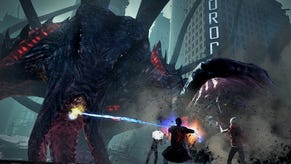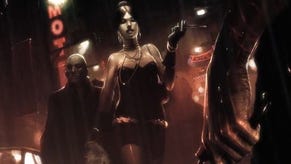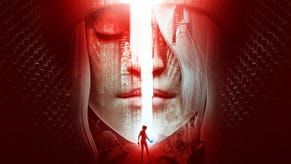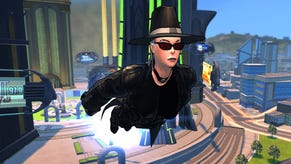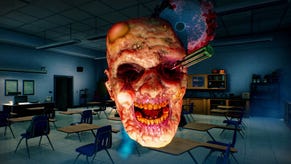Ragnar Tørnquist On The Secret World: Part 1
Interview
After spending some time at Funcom's Oslo HQ to see The Secret World, I sat down with project lead Ragnar Tørnquist to chat about the game, the process that led up to it, and how it fits in with his philosophy of gaming. In part one of our chat we talk about the game's origins, find out why we should care about each of the three factions, how Funcom is able to make games that don't match the trends, some of the more peculiar and esoteric plans for blurring our realities, and finally how the game is going to inevitably lead to Tørnquist's brutal murder.
RPS: When did The Secret World start?
Ragnar: The pre-production on The Secret World started in 2006. But the pre-production on the game that became The Secret World began in 2002.
RPS: What was that called?
Ragnar: It was called Cabal. And it was set in the same universe, with the same back story, but it was set in the 1920s. It was a first-person game. We even have a prototype of it that we showed at E3 in 2003. Then the Conan license came to play at that time, so we let Cabal rest. It was a great game. Actually, the first concept I wrote for it was called The Entire World Online. But if you look at the documents it’s pretty much the same, except for the time period.
RPS: It’s an interesting time period, pre-WW2, so you don’t have the Nazis as your go-to.
Ragnar: The Twenties were fantastic. The Secret World has taken inspiration from Lovecraft, and Indiana Jones, but much more before than in the current incarnation. The 1920s were awesome because the world was still a mystery. But at the same time you had planes, you had cars, technology was emerging, you could travel to all these spots around the world and explore them.
RPS: Presumably it was your decision to move from Cabal to The Secret World. Why the change?
Ragnar: It was a discussion. Everybody was sort of torn about the 1920s. For us who love that sense of adventure and the unknown, it was easy to see how that setting could work. But a lot of other people felt it’s a difficult age to nail down. It’s an unknown period, especially for games. Everybody felt the modern day would be a lot easier for people to get and understand, and also there are very few contemporary real-world games that aren’t shooters or racing games. It was a choice that I think was absolutely right. And there are still mysteries in the world! The world is still unexplored. The feeling that there’s nothing left to explore, there’s nothing left to understand, there’s nothing left to decipher – that’s a dull thing. But there are still mysteries out there we don’t understand, whether they be spiritual, religious, scientific or magical.
RPS: Like mapping the human genome was meant to be this big answer, but it’s only uncovered thousands and thousands more mysteries. Or getting down to quantum scale, and discovering more giant mysteries.
Ragnar: Absolutely. And we want to capture that in The Secret World too. Although a bit more fantasy. That idea that opening the mystery box and there’s another box in there. And open that and there’s another box in there. The deeper you dig, the deeper you need to dig.
RPS: Do you think it’s going to be difficult to convince people to trust you that the back story is so deep? Most games have a back story, but it’s a thin layer. There’s no depth.
Ragnar: I don’t think so. I think the moment people start playing they’re going to feel there’s something more to it. But we don’t explain everything. We throw things out there and people will have to learn the answers for themselves. That we require more from the player, to be able to realise and be comfortable with the fact that you’re not going to understand half the things that are happening, that’s going to require digging into the story for themselves. We have this Lore system that allows people to piece the back story together. I think the ARG has shown that we have a lot of layers. The team at Funcom has proven that we do know how to create universes and how to build stories.
RPS: But how long has The Secret World really existed, for you?
Ragnar: The late 1990s. I wrote a couple of game concepts in the same type of genre. One was called Heaven On Earth, or Heaven And Hell. It was that sort of contemporary fantasy setting, and that was written in 1997, 1998. I also worked on the design for another game called Miracle, late ‘90s, early 2000s, so it’s been twelve, thirteen years that this idea’s been germinating in my head. I love fantasy, but I think it’s such a shame that there are so few games that take fantasy into the real world, into the present day. That’s pervasive in comics and books, movies and TV.
RPS: Isn’t it much easier to create a post-apocalyptic wasteland though?
Ragnar: That is absolutely true. It’s harder to recreate reality. The bar is set so much higher. We have to add so much detail, and pay so much attention to detail, to make it feel believable. While in a regular fantasy game you can get away with a lot less, because you’re painting in broad strokes. But we’re painting in detail.
RPS: You’ve talked about the player faction the Dragon, who seem to be a group of anarchists, but with a motivation?
Ragnar: We’ve tried to stay away from the world “anarchist” because that calls to mind firebombs and so on, but they are people without a concrete plan. Or at least that’s what it seems like for the player. You join the Dragon, and it doesn’t seem like there is a plan. Or a structure. Or organisation. When you join the Illuminati you feel like you’re joining the ranks of either this massive corporation, or this massive army. You get your instructions, you know exactly where you are and what you do. You know what your rank is. And the Dragon is – you arrive at the Dragon HQ and there’s almost nobody there. The whole organisation is very – I’m probably saying too much now, but screw it – while the Templar and Illuminati are solid as stone and have been around for ages, the Dragon – while it’s also been around for ages – it forms and then disbands, forms and then disbands, and every time their intention it to create these ripples. And they don’t even tell you why these ripples need to be created. It’s those tsunamis that are created at the end of it that will be important, that will wash across the world and change everything. So it’s going to be frustrating for some people to play the Dragon. They’re philosophical anarchists.
RPS: The word that came to my mind was “hacktivist”. That sense of…
Ragnar: Oh no! The Dragon is Anonymous!
RPS: Well exactly. When trying to get my head into the space of these types recently, their motivations are fascinating to try to figure out.
Ragnar: Or at least the motivation they claim to have. But yeah, the Dragon are definitely the guys who would, for the right reasons, hack into some giant corporation and try to change the world. They wouldn’t do it for the lulz, they would do it for the ripples.
RPS: That’s R, P, L, Z, yes?
Ragnar: That’s something we’re taking. But we definitely don’t want them to be these destructive anarchists.
RPS: Are they constructive?
Ragnar: Are they… Play the Dragon and you’ll find out… See – at this point everybody’s just going to play the fucking Dragon!
RPS: Go on then, sell Templar and Illuminati right now.
Ragnar: The Illuminati have the best HQ. They have amazing gas masks! I mean, come on. They also have the best parties. They are the giant corporation, they’re the ones who pull the strings, this hidden vast corporate structure that is invisible to everybody and influences everything. They are that shadow government. They’re the classic secret society, the ones who rule the world. While the Templars are the kick-ass crusaders, who go out and fight demons, who aren’t afraid of anything, and are willing to do whatever it takes to destroy evil. They’re based in London, it’s the best hub. It’s the social hub, the capital of the Secret World. New York is much more focused around the headquarters of the factions. With the Templars you live in the capital, you’re the ruling elite of The Secret World. If you want that motivation, it’s there. With the Dragon, where is the motivation? Well, it’s going to come out, but it’s going to be weird. Some people are going to be turned off by the Dragon, and we want them to be. But we want people to be invested before they even buy the game, they’ll know who they’re going to be.
RPS: You’ve said you’re going to try to make players hate the other factions. How are you going to do that without making players hate their own faction?
Ragnar: There’s always a rivalry between the factions that’s based on mutual respect. But there’s definitely age-old hatred between the Illuminati and the Templars. The Templars drove the Illuminati out of Europe, and that’s why they settled in North America. We are going to give players missions that are all about sabotaging the other societies, trying to steal their secrets and destroy their networks. We’re definitely going to make players feel like their faction is the one with all the right answers. But we also want players to question what their faction is doing. It’s not just black and white. You’ll actually meet early on Templar characters who are questioning the Templars and their structure, especially their very heritage-based structure. The Templars always talk about “the blood”, and we have characters who question that, who say we’re opening up now, we’re letting people in who don’t have a connection to the Templars. The player doesn’t have that connection. So total dedication and belief in your faction is going to be eroded as well, questioning whether or not you’re doing the right thing, or whether your faction has the right motivation or a hidden agenda. Of course there is, and you’ll learn about that. And you’ll want to make it better.
RPS: Will you lie to the player about the other factions?
Ragnar: Yes. Absolutely. You won’t be able to tell what’s lies and what’s truth as well, so players will argue about this as well. When they start playing the game they’ll be like, “Well, you did that.” “No we didn’t, you guys did that!” When it comes to terrible things that have happened in history, the Illuminati will blame the Templars, the Templars will blame the Illuminati, and the Dragon are probably the ones who did it. We want people to question everything. Everything is true, but at the same time everything is therefore by default false. There is one Truth, and players will learn about that too, but nothing is ever simple in this game.
RPS: How has Funcom managed to spend its money on things that don’t necessarily go along with publisher’s ideals?
Ragnar: Well, we finance our own games here. We have the money to do that. We’ve always been willing to invest in things that are slightly different. And it’s paid off. Conan was a very different MMO to the other games out there. The Longest Journey and Dreamfall, those games dared to be adventures when you didn’t make adventure games. And the same with The Secret World. We said that we’re not going to make a WoW clone. We’re going to make a much more open, freeform role-playing system. A game that has a very different approach to the content. In a lot of MMOs the content is throwaway. It’s not very important. The quests aren’t that important – they’re just a way to get better equipment, more XP. While in The Secret World the missions and the content are the key to playing. You only have a couple of missions at a time – one main mission and one side mission – in addition to your story mission. Which makes you concentrate on the content. So I think we always said that it’s worth going down a different road than everyone else. We’re on the outside a little bit. We’re Norwegians!
RPS: Who are always defiantly different.
Ragnar: We’re not trying to reinvent the wheel with The Secret World. You play it like you do another MMO. You have your WASD, and your mouse control, and 1 through 7 triggering your abilities, so it’s not like we’re making a vastly different game from a mechanical level.
RPS: One of the things that does seem wildly different to me is asking players to task-switch out of the game and go to Google. How do you sell that to players? I can’t see how I would ever think to step out of a game without being told to.
Ragnar: Well, we’re already telling people they’ll need to. But there are other ways to do it. The chat channels will let people help each other out. Get clues from players. I think players will be extremely eager to help each other. I think we’re becoming a world of Googlers, so I don’t think it’s a big step to go to find things out.
RPS: I agree, but I don’t think people are used to stepping outside a game. Are you tempted to have computer terminals in the game?
Ragnar: We are probably going to include an in-game browser. But are PC gamers not used to alt-tabbing out?
RPS: They are, but they’re used to stepping out of the fantasy and into the real world. It’s a transition out of the game. So I wonder whether when I do that, when I step out of the game but I’m still playing the game…
Ragnar: You are still in The Secret World. Joel [another senior writer on the game] likes to use the phrase, “creating a mind space”. You’re always in The Secret World. So even when you’re not playing, you’re thinking about it. I think a lot of the puzzle solving will happen when you’re not playing. You’ll get stuck, you’ll go do something else, but your mind will churn over the details. The next day at work you’ll be chatting with your friends, or going on the forums, and seeing people discussing various ideas for how it can be solved. And you’ll get home and play it again that night. The great thing is you can always put a mission on pause in The Secret World, so if you get stuck you can always go and do something else.
RPS: Do you think people are willing to get stuck any more? Have you played any ‘90s adventures recently?
Ragnar: I have tried, and it’s hard to get stuck. But the problem with those games is if you get stuck you really are stuck. There’s nothing else to do. In The Secret World there’s always something else to do. Investigation missions are a big part of the game, but they’re only a percentage of the total missions. You can always circumvent them if you want to. And I think the community is going to be very responsive. They’re going to provide solutions. I remember back in the ‘80s writing into magazines to ask for clues for how to solve adventure games. Like Commodore User. I remember getting the letters back telling me what to do. Of course we’ve lost that, because gamers today are incredibly impatient if they get stuck and they get frustrated.
RPS: But we are gamers today. I’m that impatient now. I could get stuck on a game in 1992, and I’d phone my dad’s friend Ted. He’d give me a clue, and the next day I’d go back and play it. Now I’m alt-tabbing to GameFAQs so quickly.
Ragnar: But I think we learned from the ARG that people love the communal solving of puzzles, to get together, to talk about it, to come up with theories. And I think you’ll see that a certain number of players will be vanguard of puzzle solvers in the game, they’ll crack things within days and weeks. And they’ll be the ones who’ll share that knowledge with the world. I think the greatest percentage of players will look up the solutions, and that’ll be fine too. You’ll try a bit on your own, look up a clue, go back, ask somebody for help in the game, and you’ll still get that joy of unravelling the mystery, even if you’re not really solving all of it yourself. I think that’s important. The hardcore will have the satisfaction of solving it, and everybody else will have the satisfaction of not having to solve every puzzle.
RPS: How hard will they get?
Ragnar: The very hardest ones will be super-hard. That’s going to give those puzzle solvers a real challenge. We’ll gauge how long people take, and we’ll patch and modify as we proceed.
RPS: Are there plans for in-game ARGs?
Ragnar: That’s kind of a contradiction.
RPS: I guess I mean crowd-solved encounters.
Ragnar: Yes, that’s something I’ve discussed. Puzzles that do require more people to solve. Our first ARG on The Secret World required people from the Americas, Europe and Asia to work together. I’d love to do stuff like that, to encourage communal puzzle solving. With the websites, Twitter accounts, and so on, we want people to always be able to play even when they’re not playing. We want people to obsess about this, to eat away at their souls until they’re consumed by The Secret World. We’ve had characters from the game emailing members of the community already.
RPS: That’s great PR. But is it actually game?
Ragnar: Absolutely. That’ll happen once you start playing the game too. We’ll erode those boundaries between your character and yourself, and you’ll be contacted by the characters in the game.
RPS: Are you a bit scared of creating believers?
Ragnar: Yes, and I’ve already received several emails that have frightened me to the core of my being. Of course if this game is massively successful I fear for our lives. I really do. There will be some crazy people who play, because it’s a game that touches on subjects that certain people in the world are too obsessed with, but I don’t fear anything from our community or our player-base. But there are people in the world who probably shouldn’t be playing, and are going to take it way too seriously, who will hunt us down and murder us at some point.
RPS: It’s inevitable.
Ragnar: At least it will be an epic death.
RPS: It’s for your craft.
Ragnar: It would be great PR for the game as well! Everybody will play it after that. [Ragnar shoots a look at Jan, a member of the marketing team who has come in the room.] I hope I just get shot in the foot or something.
Jan: You’ve opened up some dangerous PR opportunities.
Ragnar: You could shoot me here?
RPS: What about that space just above the heart, where people get shot in movies and it just goes straight through?
Ragnar: But a flesh wound.
Join us tomorrow for part two of the interview, in which Ragnar gets into the philosophy behind the game, the importance of open endings, a good argument about truth, and whether games should have an agenda. And read our preview of the game here.












